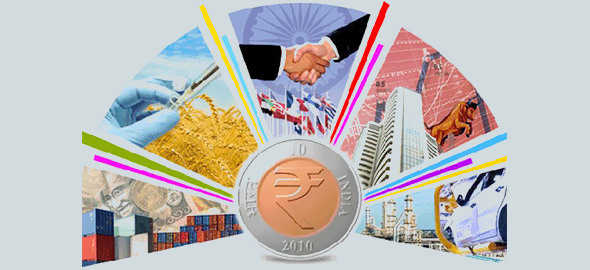What Lies in Store for the Indian Economy?

In an interview with Indian Express, in November 2015, Finance Minister Arun Jaitley said, “The biggest strength of India and the silver lining is its resilience. Our systematic firewalls have to be such that the ability to resist the global volatility is strengthened.”
Not too long before that, in July 2015, NDTV had quoted Mr Jaitley saying that India was a “bright spot among global economies,” with the manufacturing sector showing signs of reinvigoration, supported by the Make in India initiative.
“Our manufacturing sector, with Make in India initiative, is also going to pick up. From almost flat manufacturing growth 14 months ago, signs of revival are almost visible…," said our Finance Minister, at the launch of Skill India Mission.
So, are things as upbeat as all that?
Growth Predictions
In an October 2015 article, The Wall Street Journal reported that the International Monetary Fund (IMF) has lowered its forecast for India’s GDP growth by 0.2 percentage points to 7.3% for the year ending March 31, 2016. However, the IMF reiterated its predictions of 7.5% growth for the 12 months following that.
In its most recent report on the global economic outlook, Adjusting to Lower Commodity Prices, published in October 2015, the IMF said, “Growth will benefit from recent policy reforms, a consequent pickup in investment, and lower commodity prices.”
In agreement with the IMF, Focus Economics, in its December 2015 report, India Economic Outlook, said that the nation’s economic had picked up speed during the July to September 2015 quarter, witnessing 7.4% growth over the same quarter in 2014. The report stated that this acceleration was driven by increase in fixed investments, as well as government spending to fuel growth. For the future, the report predicted that government consumption was likely to decline over the next few quarters, given that the spending had been more front-loaded.
More recent data on the Indian economy has, however, been mixed, with the manufacturing PMI dropping a more-than-two-year low in November, while industrial production rose to a multi-year high in October.
What the World Bank Says
On January 7, 2016, The Financial Express published the World Bank’s growth forecasts for 2016, saying that the agency had lowered its global economic growth predictions for the year due to expectations of weak performance among the major emerging economies, as well as “anemic showings” of developed economies like the US, dampening overall activity.
The World Bank expects global growth to accelerate to 2.9%, from 2.4% in 2015, although this would still be a decline from the bank’s forecast of 3.3% growth, made in June 2015. The reason for the downgrade was concerns regarding the BRICS nations, where a simultaneous slowdown seemed to be occurring. The bank was concerned that the effects would spill over to the rest of the world.
The only country among the BRICS nations that was expected to witness appreciable improvement in its economic performance in 2016, as compared to 2015, was India. The World Bank expects the nation to see a growth rate of 7.8% in 2016, up from 7.3% in 2015.
What India Needs to do to Turn Predictions to Reality
The first thing that needs to be done is to ensure that important economic reforms are enacted. Hopefully, crucial bills, such as the Goods and Service Tax (GST) bill, that was stalled in Parliament all through 2015, would receive the nod in 2016. Such economic reforms can do wonders in simplifying the nation’s complex tax regime and make the business environment more inviting for domestic and foreign investment.
There also are various infrastructural bottlenecks that need to be removed, such as those in the power sector. According to the IMF report on India’s economic outlook, in order to fuel growth, India needs to “implement reforms to education, labor, and product markets to raise competitiveness and productivity.”
The report also called for the central government to “overhaul its tax system,” reduce subsidies and implement market-based pricing for natural resources in order to boost investment.
All in all, India is well positioned to shine in 2016, albeit with the right kind of support.
 Rakesh Wadhwa. Ever since, I was a school boy, I knew India was on the wrong path. Socialism was just not what we needed to get ahead. Government controlled our travel; government controlled our ability to buy and sell; and government controlled our freedom to move our money. My life has focused on the inherent rights people have. When I was in college, I never understood, what the governments meant by their "socialistic attitude". If people are free to buy, sell and move their capital themselves without any restrictions by state, then the welfare of people is inevitable & hence the countries they live in will become wealthy. The government has no right whatsoever, to point a finger at me or my business. I am not a revolutionary. I just want to light up my cigarette and not get nagged about it. I believe in non-interfering attitude to attain more.
Rakesh Wadhwa. Ever since, I was a school boy, I knew India was on the wrong path. Socialism was just not what we needed to get ahead. Government controlled our travel; government controlled our ability to buy and sell; and government controlled our freedom to move our money. My life has focused on the inherent rights people have. When I was in college, I never understood, what the governments meant by their "socialistic attitude". If people are free to buy, sell and move their capital themselves without any restrictions by state, then the welfare of people is inevitable & hence the countries they live in will become wealthy. The government has no right whatsoever, to point a finger at me or my business. I am not a revolutionary. I just want to light up my cigarette and not get nagged about it. I believe in non-interfering attitude to attain more. 
 The Bastiat Award is a journalism award, given annually by the International Policy Network, London. Bastiat Prize entries are judged on intellectual content, the persuasiveness of the language used and the type of publication in which they appear. Rakesh Wadhwa won the 3rd prize (a cash award of $1,000 and a candlestick), in 2006.
The Bastiat Award is a journalism award, given annually by the International Policy Network, London. Bastiat Prize entries are judged on intellectual content, the persuasiveness of the language used and the type of publication in which they appear. Rakesh Wadhwa won the 3rd prize (a cash award of $1,000 and a candlestick), in 2006.
What the readers are saying…